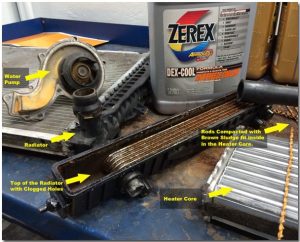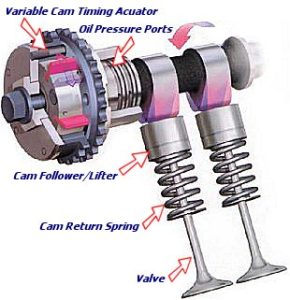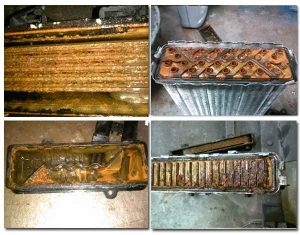One of the great scams perpetrated on car buyers is selling them on the idea of “lifetime” fluids – such as transmission fluid, for instance. And coolant. Also oil changes that don’t require doing but once every 7,500 (or even more) miles.
It’s sold this way to sell them on “low maintenance costs” – and that’s true. You just pay for it later, in the form of expensive repair costs caused or hastened by those “low maintenance costs.”
The trick works like this:
Advertise “lifetime” fluids – which leads the mark to believe that means forever. As in the fluid never needs to be changed. What it actually means is for the lifetime . . . of the warranty coverage. And that’s probably true. Those numbers – ten years, 100,000 miles as an example – are not picked out of a hat. They are arrived at after extensive durability studies that accurately foretell how long a component such as a transmission will probably last before it fails if it isn’t serviced during its “lifetime.”
After which point, of course, you’re on your own.
You may, if you have shopped for a vehicle recently, have experienced the salesman trying to sell you on an extended warranty that picks up where the factory warranty leaves off. But why would you need an extended warranty to cover major components such as the transmission – or the engine – if these are “lifetime” components? The question begs the answer.
Just as there is no such thing as a free lunch, there is no such thing as “lifetime” transmission fluid or coolant – or maintenance-free anything. The latter just means it works until it fails – at which point you are beyond maintenance.
It’s not so much that the fluids – such as the hydraulic fluid in an automatic transmission (or the gear oil in a manual transmission or engine oil) go bad. It is that they get contaminated with the byproducts of mechanical components meshing and unmeshing in an environment of high heat and pressure. Inevitably, the contaminants build up, inevitable reducing the anti-friction properties of the fluid. Fine particles accrue, like plaque inside our arteries, with the same inevitable result. A filter will filter out a lot of these small bits but what happens when the filter can no longer filter – because it’s full of those small bits and pieces?
It stops filtering.
There is a bypass built into the hydraulic circuit. Fluid continues to flow, but it’s no longer filtered. So the particles flow. Small passages narrow and – eventually – the fluid’s flow is restricted and then you have a problem. The same can and often does happen inside an engine in which the oil is left inside there too long. It can become an expensive problem when oil doesn’t properly flow at the correct rate and volume within variable/cam/valve timing systems, which cost a lot more to fix than an oil and filter change.
But at least there’s an oil drain plug.
Some vehicle manufacturers – Subaru is one such – place the oil filter in an easy to reach place so it’s easy for the owner to replace. And if you take the time to replace the oil and filter yourself, you won’t have to assume that the engine was filled with the right quantity of oil (not too much or too little). Or that the drain plug bolt wasn’t cross-threaded by the lube jockey.
If you decide to pay a shop to change the oil and filter, do yourself a favor and check the level before you leave the shop – and check (engine running) that no oil is dripping from a loose/cross-threaded drain plug bolt (or over-tightened oil filter) too.
With automatics, the car manufacturers have made it harder – because few if any transmission pans in vehicles made since the ’60s have a drain plug, furthering the illusion that automatic transmission fluid is “lifetime” fluid. This means having to drop the pan, which does have the advantage of exposing the filter – which is usually accessible once the pan is taken off. And replacing the filter once every 50,000 miles or five years is how you get a lifetime out of an automatic transmission. You’ll also rejuvenate the fluid by replacing (typically) 3-5 quarts of the total capacity. By changing some out every five years or so, you prevent all of it from becoming old fluid.
And you’;; be able to clean out the metallic grit that accumulates in the bottom of the pan.
It’s also smart to drain the cooling system on roughly the same once-every-five-years schedule and refill the system with fresh coolant as this will extend the working life of expensive parts such as the radiator and hard-to-get-at parts like the water pump and thermostat, which are often (in newer engines) buried deep underneath an array of other parts that have to be removed first, before it’s possible to get at parts like the water pump and thermostat.
Brake fluid is another, while we’re on the subject. You can see how this fluid ages by looking at the way it transitions from clear/light-honey-colored to darker shades of brown before turning black inside the master cylinder, which is often not looked at – until things have progressed such that you (or your mechanic) has to look at it.
If you’d like to avoid expensive brake system repairs – new calipers, new ABS pump, new master cylinder – changing the brake fluid once every five years or so will help avoid the need.
The car manufacturers want you to believe such needs aren’t part of the deal. And that’s true – if you’re ok with the “lifetime” of a new car that’s ten years or less.
. . .
If you like what you’ve found here please consider supporting EPautos.
We depend on you to keep the wheels turning!
Our donate button is here.
If you prefer not to use PayPal, our mailing address is:
EPautos
721 Hummingbird Lane SE
Copper Hill, VA 24079
PS: Get an EPautos magnet or sticker or coaster in return for a $20 or more one-time donation or a $10 or more monthly recurring donation. (Please be sure to tell us you want a magnet or sticker or coaster – and also, provide an address, so we know where to mail the thing!)
If you like items like the Baaaaaa! baseball cap pictured below, you can find that and more at the EPautos store!












How Long is a “Lifetime”?….for Toyota and others…a lot shorter….
Starbuck revealed on X that crosshairs have been placed on Toyota, “one of the most trusted brands in America but they’ve gone totally woke.”
The slave owner’s…the control group…. own BlackRock, Vanguard and State Street….who are are big share holders in Toyota…
One commonality with many of these woke companies is that BlackRock and Vanguard and State Street are usually in the top ownership spots – able to sway corporate decision-making in the boardroom.
https://www.zerohedge.com/political/robby-starbuck-targets-toyota-anti-woke-campaign-expands-across-corporate-america
Toyota….Their reliability is going to hell too…..DEI attacks again?….
Toyota’s New V6 Engine Has Major Problems
https://www.youtube.com/watch?v=EyI4ujjxxuk
diversity hire assembles engine…engine blows up….
The slave owners…the control group…own BlackRock and Vanguard and State Street are usually in the top ownership spots in these car manufacturers…..are able to control corporate decision-making in the boardroom…..
So they have destroyed and weaponized all the cars….and gave the whole car market to China…their communist friends….which has their model slave control system…..
15 years ago, a Ford Exec told me they design for a serviceable life of 15 years or 150K miles…225K miles for light trucks. With modern engineering, It is most likely you can get there with just oil/filter and air filter changes. You might need some emissions repair with all that oil you will be burning 🙂 I would recommend using a grade of oil at least one step up from their recommendation. They use low grade oil to lower the CAFE fines they have to pass on to their customers.
In the mid 60s I went to work for my next door neighbor in his radiator shop as a high school kid. He pointed out more than once that a radiator should last a lifetime if treated right. He made good money on people who didn’t. After high school I went to work for a heavy truck, 60 ton mining equipment transport and police/ AAA towing company out of Los Angeles. The crusty old mechanic kept everything on the road, and driven by some real who cares abusers, longer than most things would last in the hands of the common vehicle purchaser. It is not likely that anyone else around here has seen a Chevy 327 V-8 torn down that just wore out after 450,000 tow truck miles back in 1969.
Bottom line is I have never replaced a radiator, engine or transmission (that was not defective to begin with) in my long driving life. All because of routine maintenance done on or before it is due. Pay more for the synthetics if it makes you feel better, but IMHO time and miles is much more important than costly tech chemicals.
Similar story here, Torino –
I take care of my stuff and that’s why my stuff does not need to be replaced. My 23-year-old Nissan pick-up runs as well as it did when new. Because I keep it as new. And so I don’t have to figure out a way to come up with the $30k-plus it takes to buy a new truck!
Everyone was for longer oil changes, now they’re against it. I followed the recommended 10,000 mile oci for my TDI. It had 530,000 when I got rid of it. I’ve got a Dodge truck that I’ve owned for 15 years, I do it once a year. Sometimes it’s 8000, but some years it was 12000. I’m not a Democrat, but with oil I trust the science.
I don’t drive all that much now, so I am usually down to almost annual oil changes, but I like to do them at 5000.
Even though the manual doesn’t list differential changes (they do want you to go to the dealer), Those get done every 20000.
Transfer case about every 30k.
Brake fluid every 3-5 years.
Due to the PITA factor, I have the garage do a transmission fluid change at 45000.
I don’t believe in lifetime fluids. A little upfront cost goes a long way.
The 2018 Jeep Grand Cherokee trans fluid change is a nightmare, I watched a video and you need a lift. Then you better follow the process exactly or forget getting it correct. There is no dipstick, and the filter is built into the pan so full replace that. There is a fill port that you’ll need it up on that lift to access. Wait! There’s more! That port – initial fill then you need to start the engine and complete the fill via the port.
I need to find a trusty local guy to get this, the transfer case, and differentials done. As, I’m done with this one!
On our very expensive motorcycle racing engines (relative), we monitor oil condition hourly. I even take apart the filter to inspect for particles, etc…. to hopefully avoid the disastrous results of a blown engine.
The devil is in the details, literally. Oil filter quality is now suspect. The whizz bang newer extended length filter for the Harley M8 has an issue with poorly formed slots in the filter core. Wondered why the lifters were a bit clattery. Took mine out drained it sure enough more than half the slots were ragged slits barely open to some totally closed. Guess Guadalajara is Spanish for s**t quality. Yep USA #1 but a Hecho in Mehico filter woo hoo.
Switched to a motor sports specialist filter maker with holes no slots. Quiet engine again. Then the debate over filter efficiency “5 micron” screams Harley. How much 5 micron? Doesn’t do much good if the oil can’t get past the core quickly. Synthetic media? A mix best?
This affects car & truck filters as well. Better unbox at the store & take a good look inside the filter. The mugwump with a wrench at the quick change place won’t be looking.
If you’re not doing your own service don’t leave the service place without a good look under the car with the engine running. My buddy’s wife drive the KIA home and the engine ran out of oil before she got home. Mr. Mugwump didn’t know how to reassemble a cartridge style filter housing and she was the victim of the negligence.
“Mugwump didn’t know how to reassemble a cartridge style filter housing”
The slaves are paid so little…they don’t care….
Hi Eric:
I watched an interesting video on how long new oil lasts (unopened – in the bottle).
Long story short: I won’t be buying “in bulk” to save money anymore…
https://www.youtube.com/watch?v=E1T4XFPgBeo
I have a 2009 Mercury Grand Marquis. It has 325, 000 miles on it. It had 61,000 when I purchased it a little over 10 years ago. I change the oil with Havoline full synthetic 5w-20 and a Motorcraft filter every 5000 miles. It gets a new trans filter and Motorcraft LV fluid yearly. Fuel filter is changed yearly along with a coolant flush. Air filter twice a year and differential oil (full synthetic) every 50,000 miles which takes about 2 years to accrue that many miles. The mass air flow is kept clean and the plugs are changed every 50,000 miles. The car runs beautifully smooth and quiet. It has been the best car I’ve ever owned. It’s like driving my recliner around!
I feel like “Lifetime” fluids are often marketed towards the US market. If your car is available in other markets, it can be interesting to look at the maintenance schedule for that market. I know that here in the US, Subaru will tell owners the CVT fluid is lifetime but in the Japanese market they call for 3 year/36K intervals. Maybe you’ll be lucky and have it last to 200k miles or maybe it’ll crap out at 70K miles.
RIP Mr. Valentine
Anon
For those who missed it:
https://www.cincinnati.com/obituaries/pwoo0946236
I had the Pathfinder in for a checkup, a recall on the airbags, and passed the test.
Did receive an estimate of 3000 dollars to change out fluids and make sure all of the sensors are functioning. A fix-it-all job for them, they want some money.
So I guess it’s time for the maintenance, scheduled for a mechanic’s shop visit to do the work.
I did change the transmission fluid once, you have to always check the coolant, oil, brake fluid. Mobil 1 and intervals of 7500 miles for new engine oil.
New brakes were installed about 10,000 miles ago.
Will It Run at Vice Grip Garage definitely knows how to get an engine to go.
I follow the wise guidance of the great Scotty Kilmer, change oil/filter every 5,000 miles, using full synthetic oil (AMSOIL for me), transmission fluid every 30,000 miles, coolant every 5 years/100,000 miles.
Wise?
Eric: “If you decide to pay a shop to change the oil and filter, do yourself a favor and check the level before you leave the shop – and check (engine running) that no oil is dripping from a loose/cross-threaded drain plug bolt (or over-tightened oil filter) too.”
Checking the plug, or even if the filter has really been replaced is a real task on engine bays with a belly-pan (to save 0.02 mpg in the CAFE). And even then, there is always the double gasket on the filter to worry about. Might not leak except under hot conditions at high engine speeds. You used to know it because some dripped on the garage floor after a trip. Now you know about it when the belly-pan overflows or the engine seizes, which ever occurs first.
I am still able to “get out and get under” and do my own maintenance, but my Fusion takes almost twice the time to do the job. Time to remove and replace all the bolts to get the belly-pan off so I can even see the stuff I need to deal with to do the changes.
I have to wonder how the quick-change places handle a filter change. Do they really drop that pan? (And, of course, do they put all the bolts back if they do?) Do they have some sort of magic tool to grab the filter? Or does the old filter stay just where it was?
The topic of fluids is a tough one. After working as an automotive engineer and having seen more dyno test teardowns and durability teardowns than your average auto tech, I’m convinced there is much mythology and misunderstanding out there in the world. Much of it is propagated by common knowledge of “what has been” to steal a phrase. The oils and coolants grandpa used are very different from modern fluids. Likewise modern materials, metallurgy, and machining tolerances are vastly improved.
Just go read Reddit car repair advice if you dare get a sense of how little people understand about automobiles, repair, and maintenance.
Just yesterday one of the “kids” roofing my garage got a flat tire on one of the many fasteners they seem to miss picking up out of my driveway on a daily basis. karma bitches!
Anyway, kid is late 20’s maybe early 30s driving Audi A4 S-line. They got the tire plugged on their own but asked to borrow my air compressor.
As I’m filling the tire I ask – what is your tire pressure. Kid says 50 psi. No way! I ask what the tire placard pressure says. He says it’s 50 psi on the tire sidewall. Ugh!
Show him where the placard is in the door jamb. 35psi.
So I fill the tire to 35psi. Looking at the other tires I can see evidence of over inflation, under inflation, and nearly corded right front tire.
Long story I know – but the point is, don’t think this guy has any clue about fluids when he can’t be bothered to know about or take care of the tires that keep the car on the road and keep him alive.
Almost every time I interact with the “common man” it is reinforced for me that we are screwed!!!
I like my tires slightly overinflated, if it says 35 I’ll probably pump ‘em to 38-40 in the front and 36-38 in the back.
The sidewall number means if you go over gust you’ll blow the tire off the rim…
>the fear oil in a manual transmission
Interesting stuff, that.
Thanks for the typo catch, Adi –
I fly without a net and my keyboard’s letters have worn off, so I sometimes miss the right one…
But fear oil is a real thing, Eric. 🙂
If you don’t keep the 90 weight fear oil in your differential topped off, you will be able to shave with the pinion gear, and all parts will overheat and become brittle, thus subject to breakage. 🙂
Tim Walz approves!
Of all the fluids that require changine, transmission fluid is the most important in my opinion.
I bought a 2012 Acura TL with 177k miles on it a couple of years ago. I don’t think the fluid had ever been changed. Typical owners ignore it even though on that car it is simpler to change than engine oil.
I did a drain and refill 2x and then another in 3k miles. The car shifted like butter afterwards and remains very good. Every year, the car gets a drain and refill.
Same thing with my Pilot and my lexus before that time.
It’s cheap insurance and makes for a more enjoyable, drivable vehicle.
Agreed, I burned my trans fluid grape juice purple on a road trip by engine braking toon much down the rocky mountains on a hot summer day. It was cherry red on the onset of the trip as part of a pre trip check. A fluid change is what got me home 1000 miles without a tow so the trans could be rebuild and serve another 38+ years
Hi swamp,
Hubby asked me last week when I last had the transmission fluid changed in my 190k mile Toyota. I shrugged my shoulders. He then asks me again, “You don’t remember when you last had it done?” My response was, “Do I ask you what are you are making for dinner?” He said, “No, you cook dinner.” Exactly. He sighed and said he would take care of it.
Kudos to the women who are more adapt than me in car care. My job is to report all funny sounds coming from the car, notify him when the maintenance light comes on, and tell him when my brakes are squeaky. After that it is out of my hands. 😁
RG – You always make me laugh!
Pretty much works the same way at my house:
Depending on your usage profile, you can get away with changing it. I bought a Lexus RX350 for the wife with 240k miles. I don’t think the fluid had been changed. I changed it and the transmission shifted smoother. I did 1 drain and refill (3.7 quarts) and am getting ready to do the second one in October. It will likely have 247k miles by then.
After that, the car gets an annual change. 3.7quarts is a 50 percent fluid exchange at that point.
Two seemingly unrelated thoughts come to mind:
First, way back in the 70s, Chrysler touted that its TorqueFlite transmission never needed service. Part of that was that its cars rarely lasted longer than 10 years or 100,000 miles. In fact, many Chrysler (and Ford and GM and AMC) vehicles were scrapped due to severe body and frame rust most of the time, but the power train was OK. Chrysler knew that almost all of their cars would be traded in or scrapped before transmission failure occurred.
Chrysler did make an exception for “severe service” such as taxis and police cars. Those did require transmission filter and fluid changes. (California Highway Patrol outfitted their cruisers at one point with an auxiliary transmission filter system that also added an extra quart of fluid. CHP had a specification requirement that cruisers be able to run at speeds of greater than 100 mph at an ambient air temperature of 100 degrees or higher for 15 minutes.)
Second, at around that same time, German cars such as Mercedes Benz and BMW were making serious inroads into the upper end of the car market. They exceeded 100,000 miles with few problems, and many made it past 150,000 or even 200,000 miles. While those cars were indeed better built, they also had meticulous maintenance schedules. While these cars cost more to buy and maintain than American cars, they lasted a lot longer.
My 2000 Sierra gets the transmission fluid and differential fluid changed every year. Dropping the transmission pan is a PITA bc there’s one bolt impossible to get to without removing the shaft & bending a bracket that supports the emergency brake cable. I bought a harbor freight transmission fluid sucker outer thing (a pump) and pull as much fluid out and replace it with new.
It’s not optimal but I figure at 390K miles whatever is gonna wear has worn –which is evidenced by how little I saw on the pan magnet.
My 1992 Chevy Lumina had a transmission fluid change schedule of every 15K miles! Probably the most lemon scented vehicle I ever owned.
Thing is, who’s asking for lifetime fluids? Is it really that much of a hardship to replace gearbox oil every 50K miles? If people claim they forget, just light up the idiot check light on the dash. It’s there for a reason, right? Or use that telemetry channel to send an email to the customer that it’s time for service. Isn’t that what they claim is the reason for the telemetry systems in the first place?
It was said that Henry Ford sent a team of engineers out to the junkyards to find the part that was most well-built. They found that the rear differentials never went bad. 100% of the vehicles had good rear diffs. So Ford ordered the engineers to design a less robust rear differential, the idea being there’s no reason to build anything better than the sum of the whole. We all laugh at that story because most of us have been conditioned (thanks to 80s era Japan) to believe the correct course of action is to find out what the rear differential team did and get the rest of the engineers up to their standard. The “lifetime” fluids are just an extension of Ford’s goal of having the vehicle become universally useless after a set period of time.
I bought an old car from my brother in law. The first thing I did was change the transmission fluid. He said it was a waste of money and then looked at me like I had two heads.
That being said, when would you recommend changing the transmission fluid on a new car? Is synthetic oil worth the cost over regular oil?
Hi Groundhog,
I personally change out the transmission fluid (and gear lube) in all my vehicles about every 40,000 miles. I consider it very cheap insurance relative to the cost of replacing a transmission or transaxle.
One of the mechanics I use said no sense changing the 25 year old tranny fluid in my TH400 as it only has about 12,000 miles on it (not burnt or discolored). I’ll probably change it next year though.
2019 Ford Ranger 2.3L Ecoboost Engine Died @104K Miles. Owner Should Be ASHAMED!
Forgot to change the oil….what happens after 50,000 miles….
https://www.youtube.com/watch?v=DayNJuybk90
The Car Care Nut on YT continues to preach about this exact same thing.
All fluids break down – ESPECIALLY turbo engine oil – which is going to wreck a lot of naive vehicle owners in the not too distant future.
Honda doesn’t even have a mileage recommendation anymore and has the dashboard tell you when the car thinks it needs an oil change.
Ignore the owners manual, listen to real techs and use common sense.
https://m.youtube.com/watch?v=Imafmy3Ycew
The car care nut is good….here is one he did on the new Toyota V8 problems….
All the new cars are getting too complicated, have too much high tech junk, are fragile and unreliable and very expensive to fix…or can’t be fixed…see EV’s and plug in hybrids….
Video….Toyota V8 New Problem Trend is Starting To Worry Me! Here’s How to Prevent It.
https://www.youtube.com/watch?v=dfGTI0sWozc